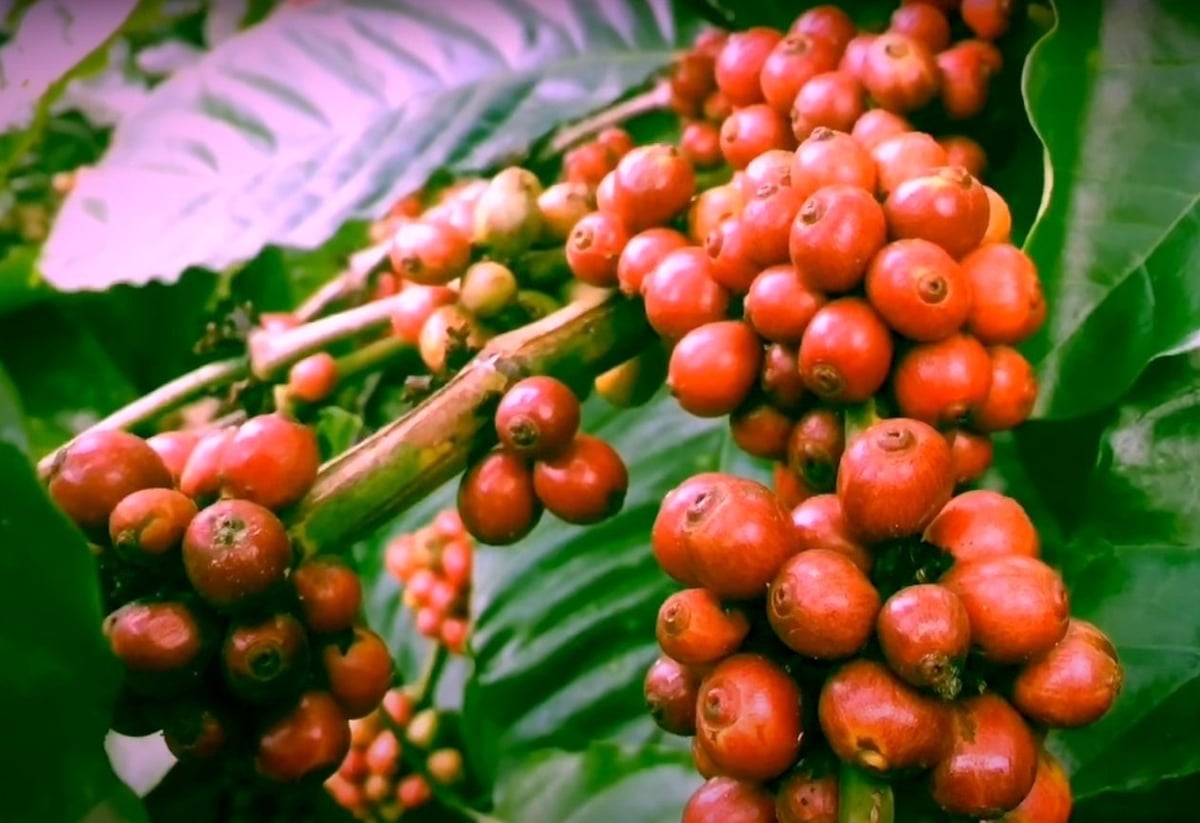November 23, 2025 | 18:57 GMT +7
November 23, 2025 | 18:57 GMT +7
Hotline: 0913.378.918
November 23, 2025 | 18:57 GMT +7
Hotline: 0913.378.918

Coffee harvest in the Central Highlands. Photo: Son Trang.
In early April, following the U.S. Government's announcement of reciprocal tariffs imposed on trade partners, including Vietnam, Vietnamese coffee prices experienced a sharp and continuous decline. On April 1, the price of coffee in the Central Highlands stood at VND 132,000/kg. Just over a week later, on April 9, the price dropped to VND 118,000/kg. Particularly in Lam Dong, the price decreased to only VND 116,000/kg.
In the global coffee market, coffee prices also continuously decreased sharply. On April 9, the price of Robusta coffee in London had fallen to USD 4,608/ton, down USD 1,251/ton compared to a record price of USD 5,849/ton. Meanwhile, on the New York market, the price of Arabica coffee dropped to 322.9 cts/lb, a decrease of 106.05 cts/lb from the peak of 429.95 cts/lb.
However, right after the U.S. Government announced a 90-day delay in the imposition of reciprocal tariffs, coffee prices in Vietnam immediately had positive reactions. On April 10, in the Central Highlands provinces of Dak Lak, Dak Nong, and Gia Lai, coffee prices rose by VND 1,000/kg, reaching VND 119,000/kg. In Lam Dong, the price increased by VND 1,300/kg to VND 117,300/kg.
Since then, coffee prices in the Central Highlands have continued to rise. By the morning of April 16, coffee prices had returned to VND 132,000/kg, equivalent to the level before the U.S. announced the reciprocal tariffs imposed on trade partners.
On the global market, both Robusta and Arabica coffee prices have also increased steadily and are now at levels comparable to those before April 2.

Robusta coffee supply increases as Brazil and Indonesia begin harvesting. Photo: Son Trang.
The increase in coffee prices can be attributed to many businesses accelerating purchases to take advantage of good exports to the U.S. during the time the U.S. Government temporarily postponed the imposition of reciprocal tariffs. The U.S. Government's delay in the imposition of reciprocal tariffs has also helped restore normal coffee trading and business activities.
However, according to Mr. Nguyen Quang Binh, a coffee market analyst, the main reason behind the recent sharp increase in coffee prices is not supply and demand, but rather the depreciation of the U.S. dollar (USD). President Donald Trump's tariff policy has created long-term risks, leading to a loss of confidence among financial investors in the USD, making them less enthusiastic about this currency. Even when the USD strengthens again in the future, investors may still be willing to "flee" from this currency to avoid potential losses in business.
When the USD is no longer seen as a reliable haven for financial investors, this opens up opportunities for commodity prices on trading floors. For coffee, when the USD/DXY index falls below 100 points, speculators feel more secure and increase their short buying on coffee trading floors.
In Vietnam, the price of the USD experienced an upward trend recently, surpassing VND 26,000. This has been the main cause in pushing coffee prices up in the Central Highlands.
Coffee prices are expected to continue rising in the coming days. However, Mr. Binh said that prices are unlikely to return to the record high of USD 5,849/ton for Robusta coffee on the London trading floor and 429.95 cts/lb for Arabica coffee on the New York floor. At first, Brazil and Indonesia began harvesting Robusta coffee, which is increasing the supply of this coffee variety.
Moreover, the U.S. is the world's largest coffee consumer, so a significant increase in global coffee prices could attract the attention of President Donald Trump's Government. With the unpredictable policies given by the U.S. Government, speculators are likely to become more cautious and calculate to stabilize coffee prices at certain levels on the trading floors.
On the morning of April 3, U.S. President Donald Trump announced the reciprocal tariff rates for 50 trading partners, including Vietnam. This led to a sharp decrease in agricultural product exports to the U.S. market. According to Vietnam Customs, in the first quarter of this year, Vietnam's coffee exports decreased by 15.3% in volume, reaching only 496,000 tons. However, thanks to a sharp increase in export prices, the turnover reached over USD 2.8 billion, an increase of 45.8% compared to the same period in 2024.
* USD 1 = VND 25,670 - Source: Vietcombank
Translated by Thu Huyen

(VAN) More than 100 shoppers queued for a chance to get a kilo or so of Japanese rice for 500 yen ($3.32) by heaping as much grain into a small wooden box as possible.

(VAN) Benchmark international prices of milled declined in October as harvests started or improved in some parts of the globe.

(VAN) Show cause orders will be issued to retailers who sell imported rice at prices exceeding the maximum suggested retail price (MSRP) of P43 per kilo, Philippines Agriculture Secretary said in a statement on Thursday.

(VAN) Coffee prices on October 20, 2025, remained stable domestically, trading at 113,500–114,500 VND/kg. Similarly, global coffee prices also moved sideways.

(VAN) By October, Vietnam’s coffee exports had surpassed USD 7 billion for the first time and will exceed USD 8 billion within this year.

(VAN) Illinois rancher says Texas, Oklahoma, Kansas lost grass and forage, forcing massive cattle liquidation.

(VAN) Coffee prices on October 12, 2025, remained flat, trading at VND 113,000–VND 114,000/kg. This week, coffee prices continued to decline sharply.